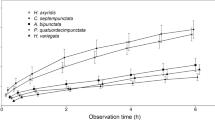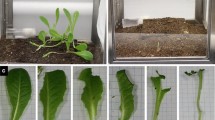Abstract
Predators can indirectly enhance plant performance via herbivore suppression, with both prey consumption and changes in prey traits (e.g. changes in foraging behaviour) contributing to the reduction in herbivory. We performed a field experiment to determine the extent of such non-consumptive effects which consisted of repeatedly placing spiders (Pisaura mirabilis) on enclosed plants (Urtica dioica) for cue deposition. Control plants were enclosed in the same way but without spiders. After cue deposition, the enclosures were removed to allow arthropods to colonize the plants and feed on them. Arthropods were removed from the plants before the subsequent spider deposition or control enclosure. During six cycles of enclosure, we quantified leaf damage on the plants. After a seventh cycle, the colonizing arthropods were sampled to determine community composition in relation to the presence/absence of spider cues. We found that the presence of chemotactile spider cues reduced leaf damage by 50 %. In addition, spider cues led to changes in the arthropod community: smaller spiders avoided plants with spider cues. In contrast, the aphid-tending ant Myrmica rubra showed higher recruitment of workers on cue-bearing plants, possibly to protect aphids. Our results show that the risk of spider predation can reduce herbivory on wild plants and also demonstrate that non-consumptive effects can be particularly strong within the predator guild.



Similar content being viewed by others
References
Abrams PA (1995) Implications of dynamically variable traits for identifying, classifying, and measuring direct and indirect effects in ecological communities. Am Nat 146:112–134
Abrams PA (2007) Defining and measuring the impact of dynamic traits on interspecific interactions. Ecology 88:2555–2562
Beckerman AP, Uriarte M, Schmitz OJ (1997) Experimental evidence for a behavior-mediated trophic cascade in a terrestrial food chain. Proc Natl Acad Sci USA 94:10735–10738
Binz H, Bucher R, Entling MH, Menzel F (2014a) Knowing the risk: crickets distinguish between spider predators of different size and commonness. Ethology 120:99–110
Binz H, Foitzik S, Staab F, Menzel F (2014b) The chemistry of competition: exploitation of heterospecific cues depends on the dominance rank in the community. Anim Behav 94:45–53
Bucher R, Binz H, Menzel F, Entling MH (2014a) Spider cues stimulate feeding, weight gain and survival of crickets. Ecol Entomol 39:667–673
Bucher R, Binz H, Menzel F, Entling MH (2014b) Effects of spider chemotactile cues on arthropod behavior. J Insect Behav 27:567–580
Cronin JT, Haynes KJ, Dillemuth F (2004) Spider effects on planthopper mortality, dispersal, and spatial population dynamics. Ecology 85:2134–2143
Davis B (1973) The Hemiptera and Coleoptera of stinging nettle (Urtica dioica L.) in East Anglia. J Appl Ecol 10:213–237
Davis B (1989) The European distribution of insects on stinging nettles, Urtica dioica L.: a field survey. Ital J Zool 56:321–326
Del-Claro K, Oliveira PS (2000) Conditional outcomes in a neotropical treehopper-ant association: temporal and species-specific variation in ant protection and homopteran fecundity. Oecologia 124:156–165
Hairston NG, Smith FE, Slobodkin LB (1960) Community structure, population control, and competition. Am Nat 94:421–425
Halaj J, Wise DH (2001) Terrestrial trophic cascades: how much do they trickle? Am Nat 157:262–281
Hambäck P, Andersson P, Bukovinszky T (2012) Trait-mediated effects modify patch-size density relationships in insect herbivores and parasitoids. In: Ohgushi T, Schmitz OJ, Holt RD (eds) Trait-mediated indirect interactions: ecological and evolutionary perspectives. Cambridge University Press, Cambridge, pp 466–488
Hawlena D, Schmitz OJ (2010) Herbivore physiological response to predation risk and implications for ecosystem nutrient dynamics. Proc Natl Acad Sci USA 107:15503–15507
Hawlena D, Strickland MS, Bradford MA, Schmitz OJ (2012) Fear of predation slows plant-litter decomposition. Science 336:1434–1438
Hodkinson I (1974) The biology of the Psylloidea (Homoptera): a review. Bull Entomol Res 64:325–339
Lima SL, Dill LM (1990) Behavioral decisions made under the risk of predation: a review and prospectus. Can J Zool 68:619–640
Lind J, Cresswell W (2005) Determining the fitness consequences of antipredation behavior. Behav Ecol 16:945–956
Mestre L, Bucher R, Entling MH (2014) Trait-mediated effects between predators: ant chemical cues induce spider dispersal. J Zool 293:119–125
Ohgushi T (2012) Community consequences of phenotypic plasticity of terrestrial plants: herbivore-initiated bottom-up trophic cascades. In: Ohgushi T, Schmitz OJ, Holt RD (eds) Trait-mediated indirect interactions: ecological and evolutionary perspective. Cambridge University Press, Cambridge, pp 161–185
Oksanen J, Blanchet FG, Kindt R, Legendre P, O’Hara RB, Simpson GL, Solymos P, Stevens MHH, Wagner H (2013) Vegan: community ecology package. R package version 2.0.7. University of Oulu, Oulu
Oksanen L, Fretwell SD, Arruda J, Niemela P (1981) Exploitation ecosystems in gradients of primary productivity. Am Nat 118:240–261
Persons MH, Walker SE, Rypstra AL, Marshall SD (2001) Wolf spider predator avoidance tactics and survival in the presence of diet-associated predator cues (Araneae: Lycosidae). Anim Behav 61:43–51
Persons MH, Walker SE, Rypstra AL (2002) Fitness costs and benefits of antipredator behavior mediated by chemotactile cues in the wolf spider Pardosa milvina (Araneae : Lycosidae). Behav Ecol 13:386–392
Phillips ID, Willis CK (2005) Defensive behavior of ants in a mutualistic relationship with aphids. Behav Ecol Sociobiol 59:321–325
Polis GA (1991) Complex trophic interactions in deserts: an empirical critique of food-web theory. Am Nat 138:123–155
Preisser EL, Bolnick DI, Benard MF (2005) Scared to death? The effects of intimidation and consumption in predator-prey interactions. Ecology 86:501–509
Rasband W (2011) ImageJ. Available at:http://imagej.nih.gov/ij
R Development Core Team (2011) R: a language and environment for statistical computing. Vienna, Austria. Available at: http://www.R-project.org/
Rosenzweig ML (1973) Exploitation in three trophic levels. Am Nat 107:275–294
Rypstra AL, Buddle CM (2013) Spider silk reduces insect herbivory. Biol Lett 9:20120948
Sanders D, Platner C (2007) Intraguild interactions between spiders and ants and top-down control in a grassland food web. Oecologia 150:611–624
Sanders D, Schaefer M, Platner C, Griffiths GJ (2011) Intraguild interactions among generalist predator functional groups drive impact on herbivore and decomposer prey. Oikos 120:418–426
Schmidt-Entling MH, Siegenthaler E (2009) Herbivore release through cascading risk effects. Biol Lett 5:20090436
Schmitz OJ (1998) Direct and indirect effects of predation and predation risk in old-field interaction webs. Am Nat 151:327–342
Schmitz OJ (2003) Top predator control of plant biodiversity and productivity in an old-field ecosystem. Ecol Lett 6:156–163
Schmitz OJ, Beckerman AP, O’Brien KM (1997) Behaviorally mediated trophic cascades: effects of predation risk on food web interactions. Ecology 78:1388–1399
Schmitz OJ, Hambäck PA, Beckerman AP (2000) Trophic cascades in terrestrial systems: a review of the effects of carnivore removals on plants. Am Nat 155:141–153
Schmitz OJ, Krivan V, Ovadia O (2004) Trophic cascades: the primacy of trait-mediated indirect interactions. Ecol Lett 7:153–163
Schmitz OJ, Hawlena D, Trussell GC (2010) Predator control of ecosystem nutrient dynamics. Ecol Lett 13:1199–1209
Sih A (1980) Optimal behavior: can foragers balance two conflicting demands. Science 210:1041–1043
Stadler B, Dixon AF (2005) Ecology and evolution of aphid–ant interactions. Annu Rev Ecol Evol Syst 36:345–372
Stoks R, De Block M, McPeek MA (2005) Alternative growth and energy storage responses to mortality threats in damselflies. Ecol Lett 8:1307–1316
Storm JJ, Lima SL (2008) Predator-naïve fall field crickets respond to the chemical cues of wolf spiders. Can J Zool 86:1259–1263
Strong DR (1992) Are trophic cascades all wet? Differentiation and donor-control in speciose ecosystems. Ecology 73:747–754
Terborgh J, Estes JA (eds) (2010) Trophic cascades: predators, prey, and the changing dynamics of nature. Island Press, Washington DC
Thaler JS, Griffin CAM (2008) Relative importance of consumptive and non-consumptive effects of predators on prey and plant damage: the influence of herbivore ontogeny. Entomol Exp Appl 128:34–40
Trussell GC, Schmitz OJ (2012) Species functional traits, trophic control and the ecosystem consequences of adaptive foraging in the middle of food chains. In: Ohgushi T, Schmitz OJ, Holt RD (eds) Trait-mediated indirect interactions: ecological and evolutionary perspectives. Cambridge University Press, Cambridge, pp 324–338
Turner AM, Montgomery SL (2003) Spatial and temporal scales of predator avoidance: experiments with fish and snails. Ecology 84:616–622
Weisser WW, Braendle C, Minoretti N (1999) Predator-induced morphological shift in the pea aphid. Proc R Soc B 266:1175–1181
Werner EE, Peacor SD (2003) A review of trait-mediated indirect interactions in ecological communities. Ecology 84:1083–1100
White T (1978) The importance of a relative shortage of food in animal ecology. Oecologia 33:71–86
Wilder SM, DeVito J, Persons MH, Rypstra AL (2005) The effects of moisture and heat on the efficacy of chemical cues used in predator detection by the wolf spider Pardosa milvina (Araneae, Lycosidae). J Arachnol 33:857–861
Ydenberg RC, Dill LM (1986) The economics of fleeing from predators. Adv Study Behav 16:229–249
Zuur AF (2009) Mixed effects models and extensions in ecology with R. Springer SBM, New York
Acknowledgments
We thank Laia Mestre for help in the field and Nina Kessler for technical assistance. We are grateful to the handling editor and two anonymous reviewers for comments on earlier versions of the manuscript. The study was supported by the Deutsche Forschungsgemeinschaft under Grant Number EN 979/1-1 and ME3842/2-1 to Martin Entling and Florian Menzel. Our experiment complies with the current laws of Germany.
Author information
Authors and Affiliations
Corresponding author
Additional information
Communicated by Wolfgang Weisser.
Rights and permissions
About this article
Cite this article
Bucher, R., Menzel, F. & Entling, M.H. Risk of spider predation alters food web structure and reduces local herbivory in the field. Oecologia 178, 571–577 (2015). https://doi.org/10.1007/s00442-015-3226-5
Received:
Accepted:
Published:
Issue Date:
DOI: https://doi.org/10.1007/s00442-015-3226-5




